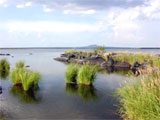 Heihe is the largest border city in the country, facing Russia across the Heilongjiang, or “Black Dragon” River in far north-eastern China. In addition to its markets and bustling border trade, Heihe is also a wonderful place to kick-start a sightseeing tour.
Heihe is the largest border city in the country, facing Russia across the Heilongjiang, or “Black Dragon” River in far north-eastern China. In addition to its markets and bustling border trade, Heihe is also a wonderful place to kick-start a sightseeing tour.
In the eyes of some people, Heilongjiang’s capital city Harbin may seem too northerly to be worth a visit. But the province is full of beautiful sights and attractions that are a bona fide must-see for any tourist. One such place is Heihe, a bustling border town facing the Amur Prefecture of Russia across the Heilongjiang River.
Heihe may not have the same cultural resonance as Harbin, or some other major cities in northeast China, but a trip there can prove a worthwhile and memorable experience.
Heihe is most famous for the Wudalianchi scenic area in the southwest of the city. Wudalianchi, translated as “Five Large Linking Lakes’, is a state-level nature reserve and ranked among the top 40 scenic attractions in the country.
The reserve is a natural volcanic area, which acts as a “living museum” for volcanologists. The lakes were formed by volcanic eruptions three centuries ago, when flowing lava blocked the White River. Thus was formed a chain of natural barrier lakes.
Each lake is a different shape and size from the next. They are natural sinks for many kinds of minerals, and each lake turns a different color in the sunshine – whether green, blue or yellow.
The lakes are surrounded by 14 volcanoes formed tens of thousands of years ago, which present a magnificent and unique spectacle of volcanic landforms. The mountains are covered with dense forests of pine and silver birch, and the slopes contain a myriad of deep limestone caves. The temperature in the caves is consistent at about ten degrees below freezing, making it icy inside even at the height of summer. Entering the caves, you feel immured inside a beautiful crystal palace, surrounded by ice sculptures that shine luminously against the colorful lamp light.
A brisk hike to the peak of the highest volcano, called “The Old Black Mountain”, rewards you with a panoramic view of the whole area. The lakes shine like pearls, dotted around the valleys that nestle between the mountains. Ancient reddish-brown or blackened lava snakes for miles down the hillsides, resembling long sleeping dragons.
Wudalianchi is also famous for the natural mineral water that gushes from the mountain springs. Scientists say the spring water contains 40 types of minerals, and is very good both for maintaining your health and treating medical ailments. It has been proved to have certain curative effects for a number of diseases including stomach aches, anemia, high blood pressure and skin disease.
Wudalianchi’s mineral water now enjoys an equal fame in the world to Vichy mineral water from France and Caucasus mineral water from Russia. This has encouraged sanatoriums and health centers to open in the area, receiving thousands of people each year.
Another famous tourist attraction in Heihe is Woniu Lake Holiday Village, 15 kilometers from the downtown area. The place is blessed with beautiful mountains, luxuriant vegetation, clear water and fresh air.
It is a wonderful resort in summer, when tourists come to enjoy sightseeing and all sorts of recreational activities. In winter, the snow-covered mountains and the frozen lake provide ideal places for skating, skiing and other ice and snow sports. Since 1999, the place has been designated a “branch venue” for the annual Heilongjiang International Skiing Festival.
As a major trade city straddling the border of China and Russia, Heihe is imbued with a strong Russian ethnic flavor. Many of the city’s buildings bear the architectural mark of classic Russian design. And in the downtown area’s Russian Commercial Street, you can find all kinds of Russian-produced goods, such as arts and crafts, clothes, foodstuffs and other daily necessities.
But by far the best place to experience the blend of Chinese and Russian culture is Heihe Island, just 750 meters from its sister city of Blagoveshchensk. This is the ancient seat of Eastern Russia’s Amur Prefecture.
The island is a trader’s paradise, full of merchants jostling each other to barter for Chinese and Russian commodities. It has the largest international trade market in China's border regions, and attracts hordes eager business people, customers and tourists.
Heihe and Blagoveshchensk jointly operate border tours that present the region to interested sightseers. In Heihe, visitors can join a tour group organized by local travel agencies for an exciting trip to Russia.
In spite of its distance from Beijing and other major Chinese cities, Heihe is actually very conveniently situated. Harbin is accessible from most of China’s main airports, and from there, Heihe is just a 12-hour train or long distance bus journey further. There are many hotels in the city, and you will find accommodation both cheap and cheerful.
(CRI December 4, 2002)
|

